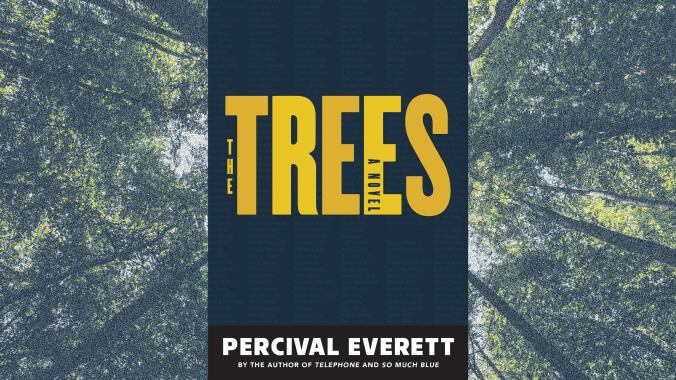America’s racist past (and present) haunts Percival Everett’s thrilling, absurdist The Trees
With his latest novel, Everett deftly juxtaposes parodies of racists with the gravity of racist violence

The culprit of a string of murders eludes local police enforcement in Money, Mississippi, so detectives Ed Morgan and Jim Davis from the Mississippi Bureau Of Investigation are enlisted to help. Complicating the case, considerably, is that at each scene of the crime, the same mangled face of a Black man who resembles Emmett Till appears and disappears ghostlike: “a small Black man”; the “African-American individual”; an “Afro-American individual”; an “unidentified colored man”; “the male deceased.” With every enunciation—painfully uttered by comically stereotypical bigoted white Southern characters—the body is at once recognized and obscured, reduced to nonbeing: “no souls… just arms and legs, hands, heads and elbows, tongues, testicles and nipples, ears and eyeballs.” As the specter of a racist past turns to the walking dead, the willful ignorance of a nation is brought to the fore in Percival Everett’s The Trees. With his latest novel, Everett—who was named a 2021 Pulitzer finalist for the experimental Telephone—has written another thrilling, intelligent, and absurdist cross-genre narrative.
The Trees opens with a facetious third-person narration introducing Money as “a marker of self-conscious ignorance.” We also meet the deadbeat Wheat and his family, descendants of Granny C, a fictional Carolyn Bryant, the woman who accused 14-year-old Till of whistling at her, setting off the chain of events that would lead to his brutal murder in 1955. (In Everett’s novel, Granny C is also an avid patron of Sam’s Club.) Charlene, Wheat’s wife, berates her husband with backhanded comments. As she expresses regret for having married into the family, a much more serious Granny C relates her remorse for lying about her encounter with Till, marking an abrupt shift from humor to agony.
One of Everett’s talents is his ability to so deftly juxtapose parodies of racists with the gravity of racist violence. A case in point is when Daisy—wife of Junior Junior, son of fictional J.W. Milam, one of Till’s real-life murderers—visits local mortician Mr. Easy to arrange Junior Junior’s funeral. Daisy and Mr. Easy, before discussing service packages, hold a long conversation about the funeral home’s location, reminiscing over its previous identity as a Dairy Queen. “The kitchen became our embalming room,” Mr. Easy tells Daisy, as she remembers, “The soda fountain was right up against that wall,” all in the wake of her husband’s gruesome death. When Daisy reminds Mr. Easy that her husband’s face is beyond recognition, he reassures her, jokingly, that if she purchases the gold package, “he will look alive… like he might just sit up.” She asks if they instead offer a tin, aluminum, or wood package.
Immediately after this scene comes a chapter wherein the moronic Deputy Sheriff Delroy Digby, who goes undercover to spy on Ed and Jim, offers Sheriff Jetty a theory: What if the Black man appearing at each crime scene is actually a set of twins “so beat up, [no one] could really recognize them,” therefore clearing Jetty and the town of any responsibility. Delroy believes that if the bodies aren’t identified, the case will close and detectives Ed and Jim will leave Money. Although Jetty sees through Delroy’s idiotic reasoning, the man’s bigoted thinking is clear: that all Black bodies are identical, indistinguishable one to the next. This is then followed by a chapter in which photographs of the same dead Black man and Till are set side by side, emphasizing the capacity of violence to disrupt identity and recognition. Arranging these chapters like this draws attention to the visual rhetoric around Black individuals and America’s history of trying to hide its racism. But death does not make a body disappear, and in The Trees’ second half, other lynching victims begin showing up at the crime scenes as well.
The humor in Everett’s novel is agitated by the consistent presence of Black bodies, their presence looming over racist white caricatures and insisting on being seen and remembered. In blurring the lines between detective fiction and satire, humor and social commentary, The Trees evokes contradicting emotions. While the violence on the page elicits horror, the incredible ignorance driving the white characters turns terror into gallows humor. Complicating the depictions further, in moments of dramatic irony, Everett gives access to private meetings and conversations hidden from the main characters: The white Sheriff Jetty learns of his Black ancestry, white-passing waitress Gertrude visits a Black radical group undercover, and root doctor Mama Z gives her testimony of a lynching to an ethnic studies professor. Rather than bringing the reader closer to solving the novel’s central murders, these instances work to humanize caricatures by deepening their characters and enriching their storylines.
The Trees is both thematically dense and accessible. The story unfolds in short sentences written in everyday language across brief chapters. The narrative is less concerned with making a statement about the past through its outlandish depiction of racism than it is framing the present moment in relation to this tumultuous past. What is at first rendered as pure satire through exaggerated violence is later grounded in reality and recognized as faithful.
In the second half of the novel, Damon Thruff, the professor of ethnic studies and Gertrude’s friend, writes down the names of real lynching victims. The list takes up over nine pages in the finished book, and in this way, Everett also obliges the reader to vocalize these names, propelling them to recognize the casualties of a not-so-distant racist past. “When I write the names they become real,” Damon tells Mama Z. “[T]hey get a few more seconds here… When I’m done, I’m going to erase every name, set them free.”
Author photo: Courtesy of author
Isaías Rogel is an MFA student in the creative writing program at New Mexico State University and is pursuing a graduate certificate in the borderlands and ethnic studies program.